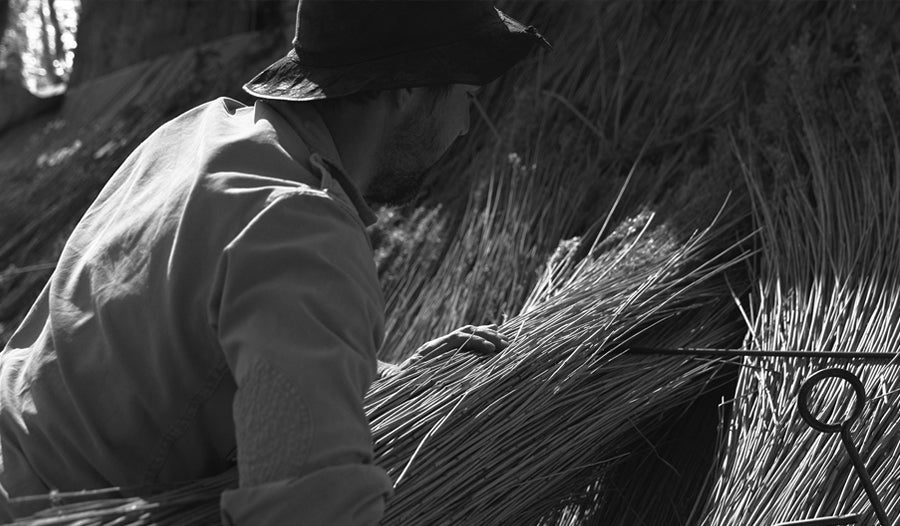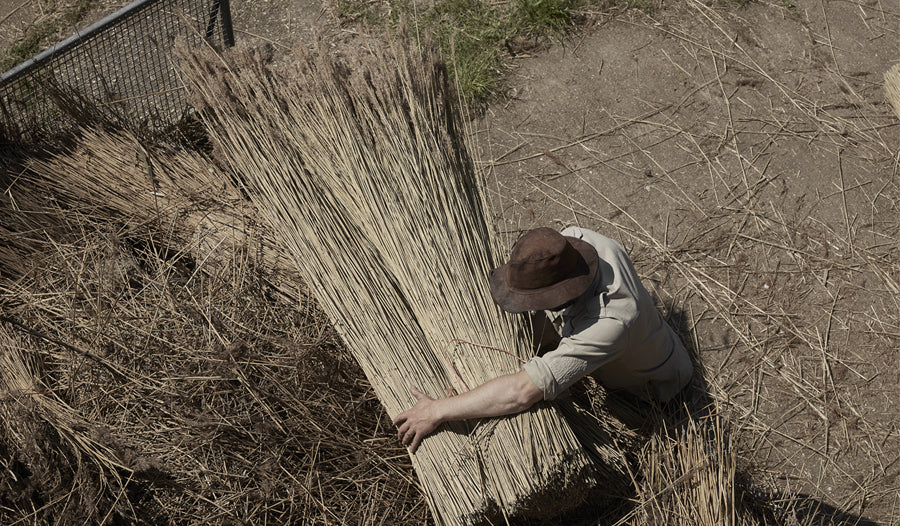
Nick Walker Master Thatcher
 Image: © Tom Bunning
Image: © Tom Bunning
In celebration of the latest issue of Selvedge, Issue 101 Grow, we're taking a deep dive into straw, a material that is as diverse as it is abundant. We're so pleased that Master Thatcher Nick Walker, who his based in the Waveney Valley on the border of Norfolk and Suffolk, agreed to talk to us about thatching, the materials and techniques used, and his process:
Tell us about the materials used in thatching.
Thatching is one of the remaining crafts to be strongly determined by the local vernacular. The materials traditionally used in different areas were based on what grew in those areas, and despite the globalised world in which we live, these traditions still continue. I thatch in Norfolk and Suffolk, a place rich with wetland areas, where reed and sedge grow, as well the drier clay uplands where wheat straw thrives, and amongst these the hedges and copses where I cut my hazel wood. These natural materials are the basis of every thatched roof I create.
To thatch a roof one must first source materials. Each winter, reed cutters harvest the great stands of reed that grow in the Broads and coastal marshes. Such is the demand that I pre-order mine several years in advance. Straw is grown specifically for thatching, using old, long stemmed varieties of wheat and harvested using vintage machinery to preserve the length of the crop. The hazel wood I coppice myself, using a chainsaw and billhook.
 Image: © John Kerrison
Image: © John Kerrison
How is a roof thatched?
When the materials are gathered, the old thatch can be stripped and the new thatch applied. Starting at the bottom of the roof and working upwards, each course is densely packed and over-layered by the next course, creating a long lasting, beautiful coat. The decorative ridge is applied last, crowning the roof for decades to come. The work is steady, careful, methodical, meditative.
Working with natural materials takes a long time, for to master the techniques one must first master the materials. It took me the best part of ten years to reach the level of Master Thatcher, and still one is always learning.
When working on projects and commissions, do you have the space to put your own stamp on your work? Are there elements of 'artistic flair' involved?
At its core, thatching is a craft. Craft might be defined by the fact that before one even starts, the expected end result is known, and achievable by following a series of steps. Art has an element of the unknown—the artist will not know how their project will turn out before it is finished. Having said that, there is artistry in thatching too. The ridge pattern, for example, will be determined by the thatcher and can have a hugely influence on the appearance of the roof if not its performance. The skill in choosing, and executing, the correct pattern is something that can elevate a fair job into an exceptional one.

Image: © John Kerrison
What are the benefits of thatching roofs using traditional techniques?
Most of the techniques used in thatching are job specific—the riving of hazel wood, preparation of straw, selection of reed and negotiation of features are all skills that can only be mastered through time and experience.
These traditional techniques are important. The skills are kept alive, the buildings benefit from natural materials by allowing them to breathe, the environments such as reedbeds and hazel coppice exist because of the need for these materials—without thatching, it would be easy for reedbeds to become choked with old growth, for hazel coppice to become overgrown and good only for firewood.
 Image: © Tom Bunning
Image: © Tom Bunning
Thatch has a romantic and humble image and is traditionally associated with churches and cottages that are hundreds of years old, but have you ever used thatching for a modern application?
My work focuses mainly on conservation grade projects, such as listed cottages or ancient churches, but of late architects have realised the thatch has much to offer modern projects. As well as having a combination of intriguing texture and visual appeal, thatch performs well at shedding the rain and adding insulation. On top of this, it is by far the greenest of the building materials, requiring little input to grow or harvest apart from human labour, meaning it actually locks in carbon as opposed to producing it.
I have had the pleasure of working on projects ranging from 11th Century churches through to cutting edge passivhaus buildings, from public toilets to duck houses, though I am more usually found on the 16th and 17th Century cottages and farmhouses that abound in East Anglia.
 Image: Thatching tools. © Tom Bunning
Image: Thatching tools. © Tom Bunning
Have you ever found anything strange during your work on historic roofs?
When working on a roof, the past is ever present. Over my time on roofs, I have found old tools left or lost by previous thatchers, items placed deliberately to ward off evil and witchcraft, as well as more natural items, such huge wasps nests or angry resident squirrels.
The anti-witchcraft devices are replaced, but the squirrels are evicted.
Find out more about Nick Walker's work on his website: https://nickwalkerthatching.co.uk/
